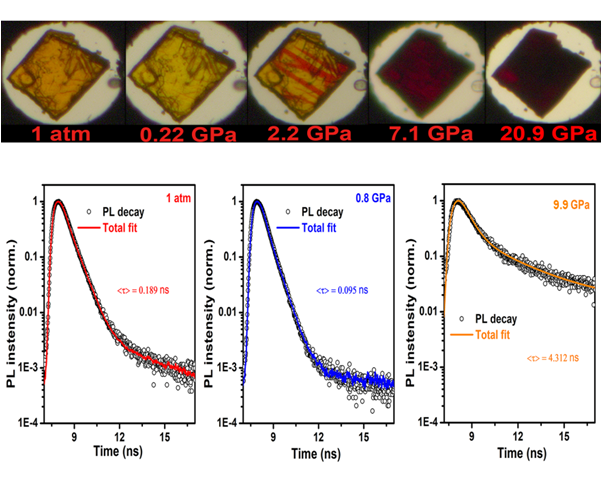Improved 2D perovskite from pressure - Drs. Ye Yuan and Lin Wang
JUNE 20, 2019
New study from a team of scientists led by Dr. Lin Wang of HPSTAR applied high pressure to tune the physical properties of 2D hybride perovskite (C4H9NH3)2PbI4. They found that pressure can tremendously improve the performace of 2D perovskite — the band gap is narrowed by~54% and the carrier lifetime is 20 times longer for (C4H9NH3)2PbI4 (BA2PbI4) compared to the value at ambient conditions. This work indicates that pressure plays an effective role in tuning the optical and electronic structures of BA2PbI4, and also provides a strategy to synthesize high-performance organic–inorganic halide perovskite materials. The study is published in recent Advanced Science.
2D hybrid perovskites exhibit strong potential for optoelectronic applications due to their superior optical and electronic properties and good stability. However, the wider band gap together with much shorter carrier lifetime of 2D hybride perovskites in contrast to 3D lead-halide perovskites have limits the practical applications. So reducing the band gap and prolonging the carrier lifetime of 2D hybride perovskites are two important aspects to be resolved to improve the performance of 2D perovskites.
"Hydrostatic pressure is a proven to be an effective tool in improving the performance of hybrid perovskite materials, especially in bulk perovskites," said Dr. Lin Wang. "So believe that it can also be used to tune the physical properties and practical performace of the lower dimentional perovskite materials."
(C4H9NH3)2PbI4 (BA2PbI4) is an important 2D organic–inorganic halide perovskite. At ambient conditions, BA2PbI4 has very large band gap and short carrier lifetime, which prevents its optical applications.
They applied high pressure to BA2PbI4 to probe the optical and electrical behavior under high pressure using in situ UV–vis absorption, PL, time-resolved PL, and impedance measurements.

First, the team applied high-pressure UV–vis absorption measurements on BA2PbI4 up to about 40 GPa to probe the band gap variations under compression. They found that the band gap of BA2PbI4 narrowed with a surprising percentage of 58.3% compared to the value at ambient conditions.
"The pressure induced Pb–I bond length shortening of the PbI6 octahedra makes the band gap gradually narrow till to the third phase transition,” explained Dr. Ye Yuan, the first author of the study. “The sample becomes amorphization after the third phase transition, which also contribute to the continuous band gap narrowing.”
They also studied the in situ high-pressure photoluminescence and time-resolved PL to trace the optical properties and carrier recombination of BA2PbI4. They found that at 9.9 GPa, the carrier lifetime is 20 times longer than that at ambient conditions.
Their further theoretical calculation shows that at 34.3 GPa, the resistance of BA2PbI4 is reduced b four orders of magnitude.
"Our study shows that pressure has effectively improved the performance of BA2PbI4, suggesting its potential applications under high pressure and and also offering a way to synthesize new hybrid perovskite materials with better performance under high pressure,” said Dr. Lin Wang.
Caption: Optical images of BA2PbI4at selected pressures and carrier lifetime of BA2PbI4 at at ambient conditions, 0.8 GPa and 9.9 GPa, respectively.
二维有机无机钙钛矿材料具有优异的稳定性和光学特性。但是禁带宽度较大、荧光寿命短、电阻值大等多种不利因素,限制了其实际应用。最近北京高压科学研究中心王霖研究员课题组,利用高压技术手段,成功实现了对典型二维有机无机钙钛矿材料(C4H9NH3)2PbI4 (BA2PbI4) 多种光电特性的调控。在压力作用下,BA2PbI4带隙可以减小~54%,而荧光寿命则可延长为初始的20倍。该工作证明压力是调节二维有机无机钙钛矿材料光电特性的有效手段,在压力影响下二维有机无机钙钛矿材料具有更广阔的应用前景。
